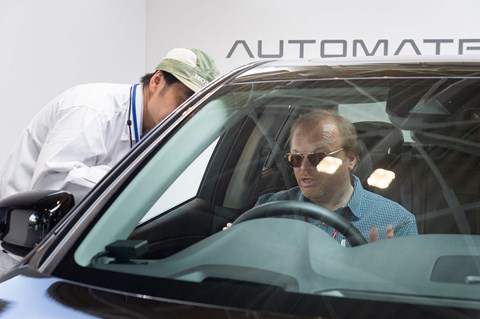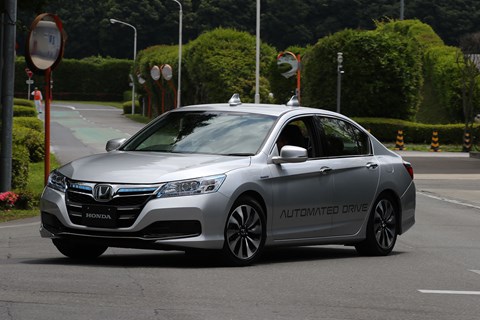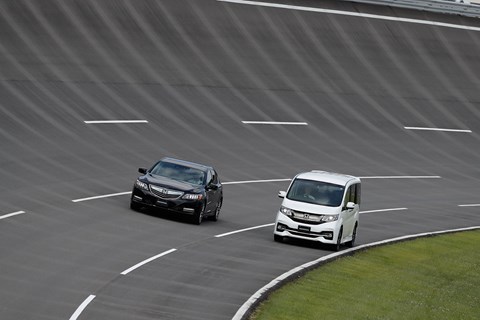► Honda plans autonomous cars by 2025
► Using AI for a ‘crash-free society’
► We test prototype driverless car
Autonomous driving is a hot topic, with car makers racing to get reliable, trustworthy systems rolled out and working for you. If the idea of dialling in your destination and letting your car drive you there appeals, we’re a little way off – and although your next car probably won’t have it, the one after that will.
Honda believes that it will be offering Level 4 autonomy by 2025, and CAR has visited its top-secret Tochigi R&D facility near Tokyo to learn more about its roadmap towards autonomy – and to drive an early prototype of its Level 3 autonomous vehicle.
What will the next-generation of its ‘Sensing’ system will look like, what does it mean for the driver, and how far away from Level 4 is it? Our ride will find out…
Back up a second – what is Level 4 autonomous driving?
In a nutshell, this is the step-change. Level 4 cars will be able to fully drive themselves in areas that have detailed mapping and good internet connectivity. There will be car-to-car and car-to-base comms, with live hazard updates to complement the vehicle’s on-board systems, all working in harmony to allow the car to make the driving decisions instead of you.

And it will be the application of Artificial Intelligence (AI) that will allow this to happen seamlessly. Once integrated AI starts making overall decisions as opposed to individual systems, such as the lane assist or cross traffic, which act separately to determine the car’s behaviour, you’re in the realms of autonomy.
Honda’s aim to be there in 2025 makes it late to the party, given that 20 car makers have already said they’ll be offering Level 4 cars in the USA by 2022. But it’s taking the challenge of accelerated development seriously – it has set up its new HGX lab to coordinate plans to develop autonomous cars.
In addition, Honda has announced strategic technical alliances with Waymo (formerly the Google self-driving car project) and the Japanese communications and data giant, Softbank.
And what’s the next step for autonomous Hondas?
Honda will have Level 3 (hands-off, driver on standby, safety-critical decisions made by the car) cars on sale in 2018 using its Sensing package. The first model featuring this will be the JDM N-Box Kei-car, but Honda says this will soon be expanded. That means your next car could probably be able to drive you most of the way to work in the morning.

Honda’s CEO of R&D in Japan, Yoichi Sugimoto, told CAR: ‘We want highway autonomy by 2020, and achieving this will involve a great deal of testing and development of our AI system. The car will decide when and where to automatically change lane, taking away the need for the driver to constantly monitor his surroundings.
‘We want an accident-free society, and by eradicating human error, 90% of collisions will be avoided.’
What’s a Level 3 autonomous car like to drive?
In reality, if you have a Mercedes-Benz, Tesla or Volvo with active cruise control, you’ll already have an understanding of what it feels like. The best examples of today’s accident-avoidance systems are already very effective – and other than the legal necessity to drive ‘hands on’, are perfectly capable of driving for hours without driver intervention.
The difference is, these systems won’t take the decision-making away from you. That’s where Honda’s Level 3 AI programming comes in. On Honda’s track, we experienced this first hand. The autonomous driving system works reasonably seamlessly. The driver starts off conventionally, but as soon as he wants the car to take the strain, it’s a case of hitting the steering-wheel mounted automatic button and letting go of the wheel. It’s just like engaging autopilot in a jet plane.
We were given the opportunity to pilot the car on a banked oval, simulating a motorway, and then in a simulated urban environment. In the former, once in auto, piloting the Honda Legend test mule in autonomous mode is a simple process. You let go of the wheel, set a speed, and the car then makes decisions regarding lane changing and maintaining distance between other cars.

Hit a queue and it slows down, but also allows you to watch the infotainment system’s screen or Skype your friends and family – when the queue clears, make sure your eyes are on the road (it has cameras trained on your pupils so it knows where you’re looking) – and it heads off again.
If you’re used to driving an active cruise control system such as Mercedes-Benz’s Distronic Plus, this won’t feel at all alien – although the decision-based lane changing will make a huge difference.
That’s the motorway, what about driverless cars in town?
On the urban course, in autonomous mode the car makes its decisions on how it reads the edge of the road and the topography its three cameras pick up. Again, the driver kicks off the process manually and then lets the car take over when ready.
Our Honda system on test did not incorporate traffic sign recognition, AEB, or high-resolution mapping, and was purely a demonstration of how Honda’s early AI software is capable of dealing with simple traffic situations. It’s designed to concentrate on identifying roadsides and junctions, and dealing with them accordingly. It will wait until the coast is clear before proceeding, and is smooth and relaxing to be a passenger in.

Its central screen displays the AI system’s confidence in what its LiDAR sensors and cameras make of the road ahead, and if that drops away, the system will nag you (by way of a tug on the seatbelt and dashboard warning) to put your hands back on the wheel and take over. So there should never be the situation where an AI-based car ends up not proceeding because it’s playing too cautious – you’ll be politely asked to take over again.
Verdict: does Honda’s autonomous car work?
Whether you like it or not, autonomous cars are coming, and Honda is making huge strides to get to the head of the pack. Autonomy has the potential to be the biggest technological disruptor since the invention of the internal combustion engine. If you take the view that self-driving cars will ultimately liberate more people out of public transport, while managing our increasingly crowded roads more effectively, then it’s a very good thing.
The development pace of AI technology, and its ability to mimic human decisions, are still very big questions. But at least the technology to make it happen is close to fruition. There’s also the thorny subject of how and where users’ driving and location data will be retained – another hot topic right now.
Whether you as a keen driver will embrace autonomous driving technology is another matter. Honda says that it’s all about the ‘joy of freedom and mobility’ – and that’s okay so long as the car has a steering wheel and manual controls. Beyond that, where will full automation leave the driver who just wants to take the long way to work, and enjoy it the old-fashioned way?
More tech stories by CAR magazine